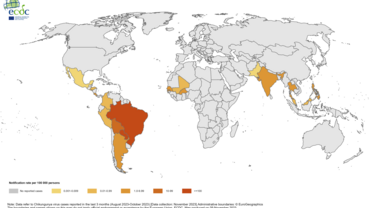Adjusting surveillance of emerging infectious disease threat due to climate change in the EUArchived
Adjustments to surveillance practices in the EU will enhance preparedness and public health response to emerging infectious diseases, thereby helping to contain human and economic costs. These are the conclusions of an article published this week in Science magazine, describing a study co-authored by ECDC.
Adjustments to surveillance practices in the EU will enhance preparedness and public health response to emerging infectious diseases, thereby helping to contain human and economic costs. These are the conclusions of an article published this week in Science magazine, describing a study co-authored by ECDC.
With the appearance in recent years of traditionally “tropical” diseases in continental Europe (e.g. chikungunya fever, West Nile fever and dengue fever) there is concern that Europe is becoming a potential “hotspot” for emerging and re-emerging infectious diseases due to climate change and globalization. The study assessed infectious diseases through weighted risk analysis, taking into account the strength of the climate change link in relation to the impact of the disease on society. This made it possible to determine whether current surveillance at EU level needs to be adjusted.
The findings of the study indicate the need for enhanced surveillance of seven infectious diseases due to the impact of climate change. If introduced, policy-driven adaptation measures should facilitate early detection of emerging infectious diseases and improve surveillance across the EU.
Read the full article: 'Monitoring EU Emerging Infectious Disease Risk Due to Climate Change' on Science







